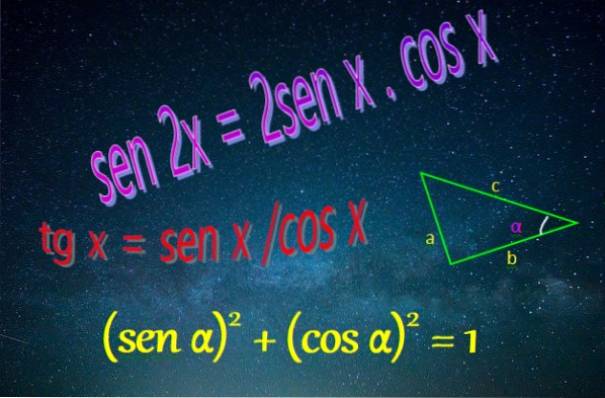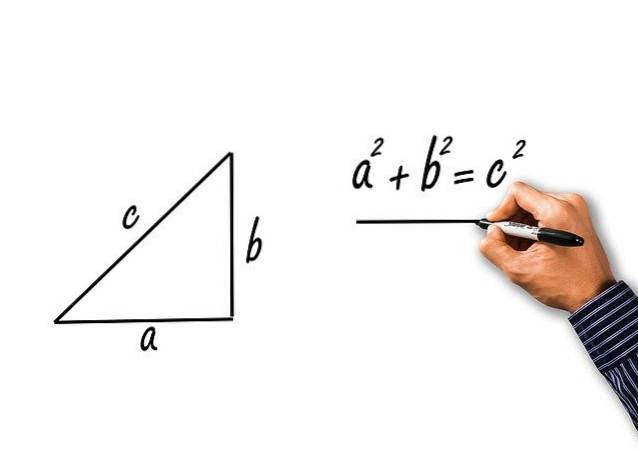
Trigonometric identities (examples and exercises)
The trigonometric identities are relationships between trigonometric ratios, which are true for any value of the variable. For example:
tan θ = sin θ / cos θ
It is a trigonometric identity that relates three ratios of the angle θ, the tangent, the sine and the cosine of said angle.

This identity is true for all values, except those that make 0 the denominator. The cos θ is 0 for θ = ± π / 2, ± 3π / 2, ± 5π / 2… Another example of trigonometric identity is:
sin x. sec x. ctg x = 1
Article index
- 1 Demo
- 2 Types of trigonometric identities
- 2.1 - Fundamental trigonometric identities
- 2.2 - Pythagorean identities
- 2.3 - Formulas for the cosine and sine of the addition / subtraction of angles
- 2.4 - Formulas for the double angle
- 2.5 - Formulas for the half angle
- 3 Solved exercises
- 3.1 - Exercise 1
- 3.2 - Exercise 2
- 4 References
Demonstration
There are two basic ways to show that a trigonometric identity is true:
1- Transforming one of the members of the equality into the other, through convenient algebraic manipulations.
2- Develop both members of the equality separately, until the respective final expressions of each one are exactly the same.
In the proposed identity, we are going to transform the left side of the equality, for which we express ctg x and sec x in terms of sine and cosine as follows:
ctg x = cos x / sin x
sec x = 1 / cos x
We substitute this expression on the left side of the identity and simplify:
sin x. (1 / cos x). (cos x / sin x) = (sin x. cos x / cos x. sin x) = 1
And the veracity of the identity is already verified.
Types of trigonometric identities
There are several classes of trigonometric identities. We will briefly describe the main ones below:
- Fundamental trigonometric identities
We distinguish two types of fundamental identities:
I) Those that are expressed through the basic ratios sine, cosine and tangent:
- sec x = 1 / cos x
- cosec x / 1 / sin x
- ctg x = 1 / tg x
- tg x = sin x / cos x
- ctg x = cos x / sin x
II) Those derived from parity. We know from its graph that sin x is an odd function, which means that:
sin (-x) = - sin x
For its part, cos x is an even function, therefore:
cos (-x) = cos x
Then:
tg (-x) = sin (-x) / cos (-x) = -sen x / cos x
Similarly:
- cotg (-x) = -ctg x
- sec (-x) = sec x
- cosec (-x) = - cosec x
- Pythagorean identities
They are obtained from the application of the Pythagorean theorem to the right triangle of legs a and b and hypotenuse c. Let's see:

The Pythagorean theorem states that:
ctwo = atwo + btwo
Dividing everything by ctwo:
ctwo / ctwo = (atwo / ctwo) + (Btwo / ctwo)
The term on the left is 1 and remembering that sine and cosine of the acute angle α are defined as:
sin α = a / c
cos α = b / c
Result:
1 = (sin α)two + (cos α)two
This identity is known as fundamental identity.
The procedure can be carried out by dividing by atwo and btwo, which gives rise to two more identities:
sectwo α = 1 + tgtwo α
harvesttwo α = 1 + ctgtwo α
- Formulas for the cosine and sine of the addition / subtraction of angles
The main trigonometric identities for cosine, sine and tangent of addition and subtraction are as follows:


Proof of sin (α + β) and cos (α + β)
These identities can be proved geometrically or also by Euler's formula:
andiα = cos α + i sin α
Let's see what happens to the formula when substituting the sum of two angles α and β:
andi (α +β) = cos (α + β) + i sin (α + β)
This expression is complex, its real part is cos (α + β) and its imaginary part is i sin (α + β). We save this result for later use and focus on developing the exponential part:
andi (α +β) = eiα ⋅ eiβ = (cos α + i sin α). (cos β + i sin β) =
= cos α⋅cos β + cos α⋅i sin β + i⋅sen α cos β - sin α⋅sen β
The real part of this expression is the one that is not multiplied by the imaginary unit "i":
cos α⋅cos β - sin α. sin β
The imaginary part therefore is:
i (cos α⋅sen β + sin α⋅cos β)
For two complex expressions to be equal, the real part of one must equal the real part of the other. The same happens with imaginary parts.
We take the saved result and compare it with this:
cos α. cos β - sin α. sin β = cos (α + β)
i (cos α⋅sen β + sin α⋅cos β) = i sin (α + β)
sin (α + β) = (cos α. sin β + sin α⋅cos β)
- Formulas for the double angle
In the previous formulas we take β = α and develop:
sin (α + α) = sin 2 α = sin α⋅cos α + cos α. sin α = 2⋅ sin α ⋅ cos α
cos (α + α) = cos 2 α = cos α⋅cos α - sin α⋅sen α = costwo α - sin two α
tg (α + α) = tg 2 α = [tg α + tg α] / [1- tg α⋅tg α] = 2tg α / 1- tgtwo α
If in the second expression we substitute costwo α = 1 - sintwo α is obtained:
cos 2 α = costwo α - (1- costwo α) = 2 costwo α -1
- Formulas for the half angle
In this last expression, let's substitute α for α / 2, the following remains:
cos α = 2 cos two(α / 2) -1
Solving for:


Solved exercises
- Exercise 1
Show that:

We are going to work the left term algebraically so that it resembles the right one. Since sin x appears in the right term, the first step is to express costwox in terms of sin x so that everything remains in terms of the same trigonometric ratio:
Then 1 - sin is factoredtwo x because it is a difference of perfect squares. To do this, it clears the fundamental identity:
costwox = 1 - sintwo x
1 - sentwo x = (1- sin x) (1 + sinx)
And the factorization is substituted in the original expression:

The term (1- sinx) is simplified and an equality remains:
1 + sin x = 1 + sinx
- Exercise 2
Solve the following trigonometric equation and give the solution for values between 0 and 360º:
tg x + sectwo x = 3
Solution
In the term on the left there are two trigonometric ratios, therefore it is necessary to reduce everything to a single one, in order to be able to solve the unknown. The term sectwo x is expressed through one of the Pythagorean identities:
sectwo α = 1 + tgtwo α
Substituting in the equation remains:
tg x + 1 + tgtwo x = 3
Rearranging the terms:
tgtwo x + tg x + 1 = 3
This equation is solved by making the change of variable:
tg x = u
ortwo + u + 1 - 3 = 0 → utwo + u - 2 = 0
This quadratic equation is easily solved by factoring:
(u +2) (u-1) = 0
Therefore u1 = -2 and utwo = 1, which is equivalent to:
tg x1 = -2
tg xtwo = 1
Finally:
x1 = arctg (-2) = 296.6º
xtwo = arctg (1) = 45º
References
- Carena, M. 2019. Pre-University Mathematics Manual. National University of the Litoral.
- Figuera, J. 1999. Mathematics. 1st. Diversified. Bolivarian Collegiate Editions.
- Hoffman, J. Selection of Mathematics Topics. Volume 4.
- Jiménez, R. 2008. Algebra. Prentice hall.
- Wikipedia. Trigonometry identities and formulas. Recovered from: es.wikipedia.org.
- Zapata, F. 4 ways to solve a quadratic equation. Recovered from: francesphysics.blogspot.com.
- Zill, D. 1984. Algebra and Trigonometry. Mcgraw hill.



Yet No Comments